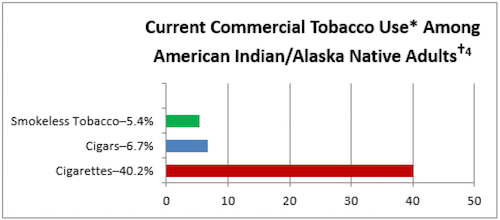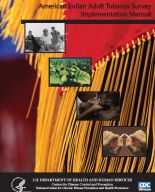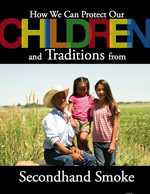American Indians/Alaska Natives and Tobacco Use
American Indian/Alaska Native is defined by the Office of Management and Budget as “a person having origins in any of the original peoples of North and South America (including Central America), and who maintains tribal affiliation or community attachment.”1 There are approximately 5.4 million American Indians and Alaska Natives in the United States—about 2% of the total population.2
American Indians/Alaska Natives have the highest prevalence of cigarette smoking compared to all other racial/ethnic groups in the United States. Some American Indians use tobacco for ceremonial, religious, or medicinal purposes.3 For this reason, it is important to make the distinction between commercial and traditional tobacco use.

Tobacco Use Prevalence
43.8% of American Indian/Alaska Native adults reported current use* of commercial tobacco in 2013.4

* “Current Use” is defined as self-reported consumption of cigarettes, cigars, or smokeless tobacco in the past month.
† Data taken from the National Survey on Drug Use and Health, 2013, and refer to American Indians/Alaska Natives aged 18 years and older.
Health Effects
American Indians/Alaska Natives have a higher risk of experiencing tobacco-related disease and death due to high prevalence of cigarette smoking and other commercial tobacco use.5,6
- Cardiovascular disease is the leading cause of death among American Indians/Alaska Natives.7,8
- Lung cancer is the leading cause of cancer deaths among American Indians/Alaska Natives.3,5,7,8
- Diabetes is the fourth leading cause of death among American Indians/Alaska Natives.7,8 The risk of developing diabetes is 30–40% higher for smokers than nonsmokers.9
Patterns of Tobacco Use
- American Indian/Alaska Native youth and adults have the highest prevalence of cigarette smoking among all racial/ethnic groups in the U.S.3,10
- Regional variations in cigarette smoking exist among American Indians/Alaska Natives, with lower prevalence in the Southwest and higher prevalence in the Northern Plains and Alaska.6
- More American Indian/Alaska Native women smoke during their last 3 months of pregnancy—26.0% compared to 14.3% of whites, 8.9% of African Americans, 3.4% of Hispanics, and 2.1% of Asians/Pacific Islanders.11
Quitting Behavior
- Quitting rates are relatively low among American Indians/Alaska Natives compared to other racial/ethnic groups.3,6,9
- An estimated 52.1% of American Indians/Alaska Natives report that they want to quit compared to 74.1% of African Americans, 69.4% of whites, 63.3% of Asians, and 58.4% of Hispanics.9
Tobacco Industry Marketing and Influence
Tobacco companies target American Indian/Alaska Native communities through extensive promotions, sponsorships, and advertising campaigns.12
- Historically, tobacco industry product promotions to American Indians and Alaska Natives featured symbols and names with special meanings to this group. For example, the American Spirit™ cigarettes were promoted as “natural” cigarettes, and their packaging featured an American Indian smoking a pipe.3
Culturally appropriate anti-smoking health marketing strategies and mass media campaigns like CDC’s Tips From Former Smokers national tobacco education campaign, as well as CDC-recommended tobacco prevention and control programs and policies, can help reduce the burden of disease among the American Indian/Alaska Native population.
Resources
Publications
Because American Indian tribes are sovereign nations and have unique cultural practices and because data from national surveys may be limited or underestimated due to small sample sizes, CDC’s Office on Smoking and Health developed the American Indian Adult Tobacco Survey to assist tribes in collecting tribal- and village-specific commercial tobacco use and secondhand exposure data.
- Native American Action Plan: Addressing Tobacco Abuse Among Pregnant & Postpartum Women [PDF–2.69 MB]
- American Cancer Society Guide to Quitting Smoking [PDF–223 KB]
Websites
- Causes of Death Among American Indians and Alaska Natives
- Americans For Nonsmokers’ Rights
- Keep It Sacred National Native Network
- Other AI/AN Resources
References
- Government Printing Office. Revisions to the Standards for the Classification of Federal Data on Race and Ethnicity, 1997 [PDF–156 KB]. [accessed 2017 Mar 1].
- U.S. Census Bureau. 2010 Census Population and Housing Tables, Table 1 American Indian and Alaska Native Population by Tribe for the United States [PDF–1.67 MB], 2013. [accessed 2015 Sep 17].
- U.S. Department of Health and Human Services. Tobacco Use Among U.S. Racial/Ethnic Minority Groups—African Americans, American Indians and Alaska Natives, Asian Americans and Pacific Islanders, Hispanics: A Report of the Surgeon General. Atlanta: U.S. Department of Health and Human Services, Centers for Disease Control and Prevention, National Center for Chronic Disease Prevention and Health Promotion, Office on Smoking and Health, 1998 [accessed 2015 Sep 17].
- Substance Abuse and Mental Health Services Administration. Results from the 2013 National Survey on Drug Use and Health: Detailed Tables. Rockville, MD: Substance Abuse and Mental Health Services Administration, Center for Behavioral Health Statistics and Quality, 2014 [accessed 2015 Sep 17].
- Espey DK, Jim MA, Cobb N, et al. Leading Causes of Death and All-Cause Mortality in American Indians and Alaska Natives. American Journal of Public Health, 2014;104(Suppl 3):S303–S311 [accessed 2015 Sep 17].
- Mowery PD, Dube SR, Thorne SL, et al. Disparities in Smoking-Related Mortality Among American Indians/Alaska Natives. American Journal of Preventive Medicine, 2015. doi:10.1016/j.amepre.2015.05.002 [accessed 2015 Sep 17].
- Heron, M. Deaths: Leading Causes for 2010 [PDF–5.08 MB]. National Vital Statistics Reports, 2013;62(6) [accessed 2015 Sep 17].
- Centers for Disease Control and Prevention. Deaths: Final Data for 2012 [PDF–2.12 MB]. National Vital Statistics Reports, 2013;63(9) [accessed 2015 Sep 17].
- U.S. Department of Health and Human Services. The Health Consequences of Smoking—50 Years of Progress: A Report of the Surgeon General. Atlanta: U.S. Department of Health and Human Services, Centers for Disease Control and Prevention, National Center for Chronic Disease Prevention and Health Promotion, Office on Smoking and Health, 2014 [accessed 2015 Sep 17].
- Garrett BE, Dube SR, Winder C, Caraballo RS. Cigarette Smoking—United States, 2006–2008 and 2009–2010. Morbidity and Mortality Weekly Report 2013;62(03):81–4 [accessed 2015 Sep 17].
- Tong VT, Dietz PM, Morrow B. Trends in Smoking Before, During, and After Pregnancy—Pregnancy Risk Assessment Monitoring System, United States, 40 Sites, 2000–2010. Morbidity and Mortality Weekly Report 2013;62(SS06):1–19 [accessed 2015 Sep 17].
- Satter DE, Roby DH, Smith LM, et al. Costs of Smoking and Policy Strategies for California American Indian Communities. Journal of Cancer Education, 2012; 27(Suppl 1):S91–S105 [cited 2015 Sep 17].
For Further Information
Centers for Disease Control and Prevention
National Center for Chronic Disease Prevention and Health Promotion
Office on Smoking and Health
E-mail: tobaccoinfo@cdc.gov
Phone: 1-800-CDC-INFO
Media Inquiries: Contact CDC’s Office on Smoking and Health press line at 770-488-5493.
- Page last reviewed: September 18, 2017
- Page last updated: September 18, 2017
- Content source:


 ShareCompartir
ShareCompartir

